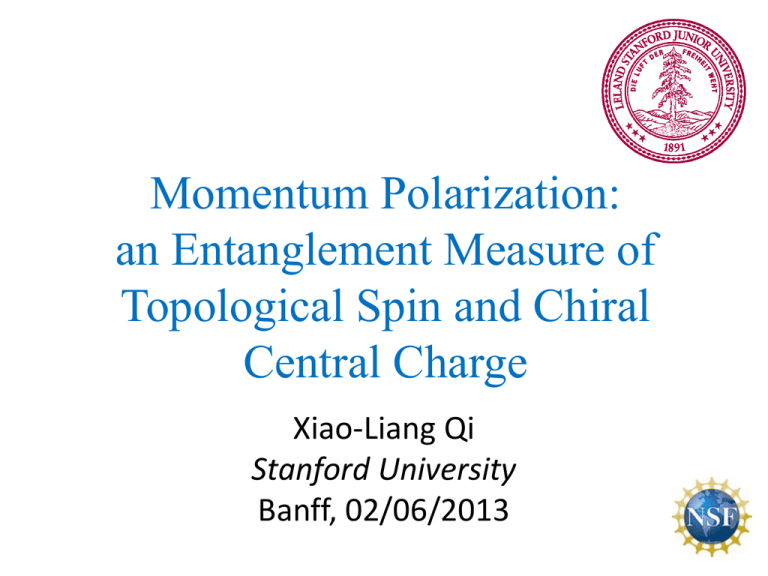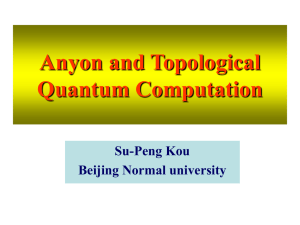201302061949
advertisement

Momentum Polarization: an Entanglement Measure of Topological Spin and Chiral Central Charge Xiao-Liang Qi Stanford University Banff, 02/06/2013 • Reference: Hong-Hao Tu, Yi Zhang, Xiao-Liang Qi, arXiv:1212.6951 (2012) Hong-Hao Tu (MPI) Yi Zhang (Stanford) Outline • Topologically ordered states and topological spin of quasi-particles • Momentum polarization as a measure of topological spin and chiral central charge • Momentum polarization from reduced density matrix • Analysis based on conformal field theory in entanglement spectra • Numerical results in Kitaev model and Fractional Chern insulators • Summary and discussion Topologically ordered states • Topological states of matter are gapped states that cannot be adiabatically deformed into a trivial reference with the same symmetry properties. • Topologically ordered states are topological states which has ground state degeneracy and quasi-particle excitations with fractional charge and statistics. (Wen) • Example: fractional quantum Hall states. 𝐵⊗ Topo. Ordered states Topological states Topologically ordered states • Only in topologically ordered states with ground state degeneracy, particles with fractionalized quantum numbers and statistics is possible. • A general framework to describe topologically ordered states have been developed (for a review, see Nayak et al RMP 2008) • A manifold with certain number and types of topological quasiparticles define a Hilbert space. 𝑐 𝑏 𝑎 𝑐 Fractional statistics of quasi-particles • Particle fusion: From far away we cannot distinguish two nearby particles from one single particle 𝑐 𝑐 Fusion rules 𝑎 × 𝑏 = 𝑐 𝑁𝑎𝑏 𝑐. Multiple fusion channels for Non-Abelian statistics 𝑏 𝑎 • Braiding: Winding two particles around each other leads to a unitary operation in the Hilbert space. From far away, 𝑎 and 𝑏 looks like a single particle 𝑐, so that the result of braiding is not observable from far away. Braiding cannot change the fusion channel 𝑐 and has to be 𝑐 𝑐 𝑖𝜃𝑎𝑏 a phase factor 𝑅𝑎𝑏 = 𝑒 Topological spin of quasi-particles • Quasi-particles obtain a Berry’s phase 𝑒 𝑖2𝜋ℎ when it’s spinned by 2𝜋. • Spin is required since the braiding of particles 𝑎, 𝑏 looks like spinning the fused particle 𝑐 by 𝜋. • In general the spins ℎ𝑎,𝑏,𝑐 are related to the braiding 𝑐 𝜃𝑎𝑏 (the “pair of pants” diagram): 𝑐 𝑐 𝑎 𝑏 𝑐 2𝜃𝑎𝑏 𝑎 𝑏 = 2𝜋(ℎ𝑎 + ℎ𝑏 − ℎ𝑐 ) Examples: 1. q/𝑚 charge particle in 1/𝑚 Laughlin state: ℎ = 𝜋𝑞 2 /𝑚 2. Three particles (1, 𝜎, 𝜓) in the Ising anyon theory 1 1 ℎ = (0, , ) 16 2 Topological spin of quasi-particles • Topological spin of particles determines the fractional statistics. • Moreover, topological spin also determines one of the Modular transformation of the theory on the torus 𝑎 𝑎 𝑎 𝑎 • Spin phase factor 𝑒 2𝜋𝑖ℎ𝑎 is the eigenvalue of the Dehn twist operation: Chiral central charge of edge states • Another important topological invariant for chiral topological states. • Energy current carried by the chiral edge state is universal if the edge state is described by a CFT. 𝐼𝐸 = 𝜋 𝑐𝑇 2 (Affleck 1986) 6 • The central charge also appears (mod 24) in the modular transformations. Measuring ℎ𝑎 and 𝑐 • The values of topological spin and 𝑐 mod 24 can be computed algebraically for an ideal topological state (TQFT). • Analytic results on FQH trial wavefunctions (N. Read PRB ‘09, X. G. Wen&Z. H. Wang PRB ’08, B. A. Bernevig&V. Gurarie&S. Simon, JPA ’09 etc) • Numerics on Kitaev model by calculating braiding (V. Lahtinen & J. K. Pachos NJP ’09, A. T. Bolukbasi and J. Vala, NJP ’12) • Numerical results on variational WF using modular Smatrix (e.g. Zhang&Vishwanath ’12) • Central charge is even more difficult to calculate. • We propose a new and easier way to numerically compute the topological spin and chiral central charge for lattice models. Momentum polarization • Consider a lattice model on the cylinder, with lattice translation symmetry 𝐿𝑦 𝑇𝑦 (𝑇𝑦 = 1) • For a state with quasiparticle 𝑎 in the cylinder, rotating the cylinder is equivalence to spinning two quasiparticles to opposite directions. • A Berry’s phase 𝑒 𝑖2𝜋ℎ𝑎 /𝐿𝑦 is obtained at the left edge, which is cancelled by an opposite phase at the right. • Total momentum of the left (right) edge ±2𝜋ℎ𝑎 / 𝐿𝑦 Momentum polarization 𝑃𝑀 = 2𝜋ℎ𝑎 /𝐿𝑦 𝑒 𝑖2𝜋ℎ𝑎 /𝑁𝑦 𝑎 𝑇𝑦 𝑒 −𝑖2𝜋ℎ𝑎 /𝑁𝑦 𝑎 Momentum polarization • Viewing the cylinder as a 1D system, the translation symmetry is an internal symmetry of 1D system, of which the edge states carry a projective representation. • (A generalization of the 1D results Fidkowski&Kitaev, Turner et al 10’, Chen et al 10’) • Ideally we want to measure • Difficult to implement. Instead, define discrete translation 𝑇𝑦𝐿 . Translation of the left half cylinder by one lattice constant Momentum polarization 2𝜋 𝑖 𝐿 ℎ𝑎 𝑦 • Naive expectation: 𝑇𝑦𝐿 𝐺𝑎 ∼ 𝑒 𝐺𝑎 contributed by the left edge. However the mismatch in the middle leads to excitations and makes the result nonuniversal. • Our key result: 𝐺𝑎 𝑇𝑦𝐿 𝐺𝑎 = 2𝜋 exp[𝑖 𝐿𝑦 ℎ𝑎 − 𝑐 24 − 𝛼𝐿𝑦 ] • 𝛼 is independent from topological sector 𝑎 • Requiring knowledge about topological sectors. Even if we don’t know which sector is trivial |𝐺1 ⟩, ℎ𝑎 can be determined up to an overall constant by diagonalizing ⟨𝐺𝑛 𝑇𝑦 𝐺𝑚 ⟩ . Momentum polarization and entanglement • 𝑇𝑦𝐿 only acts on half of the cylinder • The overlap 𝜆𝑎 = 𝐺𝑎 𝑇𝑦𝐿 𝐺𝑎 = tr(𝑇𝑦𝐿 𝜌𝐿𝑎 ) • 𝜌𝐿𝑎 is the reduced density matrix of the left half. • Some properties of 𝜌𝐿𝑎 are known for generic chiral topological states. • Entanglement Hamiltonian 𝜌𝐿𝑎 = 𝑒 −𝐻𝐸𝑎 . (Li&Haldane ‘08) In long wavelength limit, for chiral topological states 𝐻𝐸𝑎 ∝ 𝐻𝐶𝐹𝑇 |𝑎 + 𝑐𝑜𝑛𝑠𝑡. • Numerical observations (Li&Haldane ’08, R. Thomale et al ‘10, .etc.) • Analytic results on free fermion systems (Turner et al ‘10, Fidkowski ‘10), Kitaev model (Yao&Qi PRL ‘10), generic FQH ideal wavefunctions (Chandran et al ‘11) • A general proof (Qi, Katsura&Ludwig 2011) General results on entanglement Hamiltonian • A general proof of this relation between edge spectrum and entanglement spectrum for chiral topological states (Qi, Katsura&Ludwig 2011) • Key point of the proof: Consider the cylinder as obtained from gluing two cylinders • Ground state is given by perturbed CFT 𝐻𝐿 + 𝐻𝑅 + 𝑟𝐻𝑖𝑛𝑡 B A “glue” B A 𝑟=1 𝑟𝐻𝑖𝑛𝑡 B A Momentum polarization: analytic results • Following the results on quantum quench of CFT (Calabrese&Cardy 2006), a general gapped state in the “CFT+relevant perturbation” system has the asymptotic form in long wavelength limit 𝑡 • |𝐺𝑎 ⟩ = 𝑒 −𝜏0 𝐻𝐿 +𝐻𝑅 ⋅ 𝑛=0,1,… 𝑑𝑎 (𝑛) 𝑛, 𝑑𝑎 𝑛 𝐿 𝑛, 𝑑𝑎 𝑛 • This state has an left-right entanglement density matrix 𝜌𝐿𝑎 = 𝑍 −1 𝑒 −4𝜏0 𝐻𝐿 |𝑎 . • Including both edges, 𝜌𝐿𝑎 = 𝑍 −1 𝑒 −(𝛽𝑙𝐻𝑙+𝛽𝑟 𝐻𝑟) 𝛽𝑙 = ∞, 𝛽𝑟 = 4𝜏0 < ∞ 𝑅 𝜏0 𝐺𝑎 Maximal entangled state 𝐺0𝑎 𝑎 𝛽𝑙 𝛽𝑟 Momentum polarization: analytic results • 𝜌𝐿 describes a CFT with left movers at zero temperature and right movers at finite temperature. In this approximation, 𝜆𝑎 = tr 𝑇𝑦𝐿 𝜌𝐿𝑎 = tr 𝑒 𝑖 𝐻𝑙 −𝐻𝑟 𝜌𝐿𝑎 = 𝜒𝑎 𝑒 2𝜋 𝑖−𝛽𝑙 𝐿𝑦 𝜒𝑎 𝑒 𝛽 −2𝜋 𝑙 𝐿𝑦 2𝜋 −𝑖−𝛽𝑟 𝐿𝑦 𝛽 −2𝜋 𝑟 𝐿𝑦 𝜒𝑎 𝑒 𝜒𝑎 𝑒 • 𝜒𝑎 𝑞 = tr(𝑞 𝐿0 ) is the torus partition function in sector 𝑎. In the limit 𝛽𝑟 ≪ 𝐿𝑦 , left edge is in low T limit and right edge is in high T limit. • Doing a modular transformation gives the result 𝜆𝑎 = 2𝜋 exp[𝑖 𝐿𝑦 𝑐 2𝜋𝑖 − 24 𝛽𝑟 𝛽𝑟 −𝑖 𝛼= from 𝑎. ℎ𝑎 − 𝑐 24 − 𝛼𝐿𝑦 ] nonuniversal contribution independent Momentum polarization: Numerical results on Kitaev model • Numerical verification of this formula • Honeycomb lattice Kitaev model as an example (Kitaev 2006) • An exact solvable model with nonAbelian anyon 𝐻=− 𝑥 𝑥 𝐽 𝜎 𝑥 𝑥−𝑙𝑖𝑛𝑘 𝑖 𝜎𝑗 − 𝑦 𝑦 𝑦−𝑙𝑖𝑛𝑘 𝐽𝑦 𝜎𝑖 𝜎𝑗 - 𝑧 𝑧 𝐽 𝜎 𝑧 𝑧−𝑙𝑖𝑛𝑘 𝑖 𝜎𝑗 • Solution by Majorana representation with the constraint Physical Hilbert space Enlarged Hilbert space Momentum polarization: Numerical results on Kitaev model • In the enlarged Hilbert space, the Hamiltonian is free Majorana fermion 𝑇𝑦𝐿𝐹 𝑇𝑦 𝑎 • 𝑢𝑖𝑗 become classical 𝑍2 gauge field variables. • Ground state obtained by gauge average • Reduced density matrix can be exactly obtained (Yao&Qi ‘10) • 𝑇𝑦𝐿 becomes gauge covariant translation of the Majorana fermions Gauge transformation Momentum polarization: Numerical results on Kitaev model • Non-Abelian phase of Kitaev model (Kitaev 2006) • Chern number 1 band structure of Majorana fermion • 𝜋 flux in a plaquette induces a Majorana zero mode and is a non-Abelian anyon. 𝐸 𝜙=𝜋 • On cylinder, 0 flux leads to zero mode 1 + 𝛾−𝑘 𝛾𝑘+ 𝜓 𝜎 𝜙=0 𝑘 𝐸 𝑘 Momentum polarization: Numerical results on Kitaev model 𝑖𝑗 𝑍 −1 𝑒 −𝜂𝑖 ℎ𝐸 𝜂𝑗 • Fermion density matrix 𝜌𝐿𝐹 = is determined by the equal-time correlation function ⟨𝜂𝑖 𝜂𝑗 ⟩ (Peschel ‘03) + • 𝑇𝑦 = exp[𝑖 𝑘,𝑛 𝑘𝛾𝑘𝑛 𝛾𝑘𝑛 ] in entanglement + Hamiltonian eigenstates. (𝐻𝐸 = 𝑛 𝛾𝑘𝑛 𝛾𝑘𝑛 𝜆𝑛 ) • We obtain 𝑖𝑝 ℎ − 𝑖𝑝 𝐸 𝑒 2 cosh 2 𝜆𝜎,1 = det ℎ𝐸 flux 0,𝜋 cosh 2 Momentum polarization: Numerical results on Kitaev model • Numerically, 𝑁𝑦 • 𝜆𝜎 ℎ𝜎 = log 2𝜋𝑖 𝜆1 1 ℎ𝜓 = is known 2 analytically) • Central charge 𝑐 can also be extracted from the comparison with CFT result 𝜆𝑎 = 𝑒 𝑖 2𝜋 𝐿𝑦 ℎ𝑎 − 𝑐 24 • imag(log 𝜆1 ) = 𝑒 𝑐 2𝜋𝐿𝑦 𝑖 24𝛽𝑟 𝛽𝑟 −𝑖 𝑐 2𝜋 − 24 𝐿𝑦 + Momentum polarization: Numerical results on Kitaev model • The result converges quickly for 𝑁𝑦 >correlation length 𝜉 • Across a topological phase 𝐽𝑧 transition tuned by to 𝐽𝑥 an Abelian phase, we see the disappearance of ℎ𝜎 • Sign of ℎ𝜎 determined by second neighbor coupling 𝐽𝑛𝑛 Momentum polarization: Numerical results on Kitaev model • Interestingly, this method goes beyond the edge CFT picture. • Measurement of ℎ𝜎 and 𝑐 are independent from edge state energy/entanglement dispersion. In a modified model, the entanglement dispersion is 𝐸 ∝ 𝑘 3 , the result still holds. 𝐽𝑛𝑛 turned off Momentum polarization: Numerical results on Fractional Chern Insulators • Fractional Chern Insulators: Lattice Laughlin states • Projective wavefunctions as variational ground states • E.g., for 𝜈 = 1 : 2 𝐺 = 𝑃 𝐺1 ⊗ |𝐺2 ⟩ • 𝐺1,2 : Parton IQH ground states 𝑃: Projection to parton number 𝑛1 = 𝑛2 on each site • Two partons are bounded by the projection • Such wavefunctions can be studied by variational Monte Carlo. Momentum polarization: Numerical results on Fractional Chern Insulators • Different topological sectors are given by (Zhang &Vishwanath ‘12) + + + + Φ1 = P 𝑐𝐿1 𝑐𝐿2 + 𝑐𝑅1 𝑐𝑅2 𝐺1 ⊗ 𝐺2 + + + + Φ2 = P 𝑐𝐿1 𝑐𝑅2 + 𝑐𝑅1 𝑐𝐿2 𝐺1 ⊗ 𝐺2 • ⟨𝑇𝑦𝐿 ⟩ can be calculated by Monte Carlo. 𝑐 = 1.078 ± 0.091, ℎ𝑠 = 0.252 ± 0.006 • Non-Abelian states can also be described Conclusion and discussion • A discrete twist of cylinder measures the topological spin and the edge state central charge 𝑐 2𝜋 𝐿 Im log 𝑇𝑦 𝑎 = ℎ𝑎 − − 𝛼 2 𝐿𝑦 24 𝐿𝑦 • A general approach to compute topological spin and chiral central charge for chiral topological states • Numerically verified for Kitaev model and fractional Chern insulators. The result goes beyond edge CFT. • This approach applies to many other states, such as the MPS states (see M. Zaletel et al ’12, Estienne et al ‘12). • Open question: More generic explanation of this result Thanks!








